How Digital Technology Enhances Hotel Experience? Examining Experiential Marketing of Two Four-Star Hotels in Yogyakarta
on
E-Journal of Tourism Vol.10. No.1. (2023): 33-45
How Digital Technology Enhances Hotel Experience? Examining Experiential Marketing of Two Four-Star Hotels in Yogyakarta
Maryness Patrick*, William Msilu Paulo, Antonius Sumarwan
Universitas Sanata Dharma, Faculty of Economics Magister Management Program, Yogyakarta- Indonesia
*Corresponding Author: marynesspatrick1996@gmail.com
DOI: https://doi.org/10.24922/eot.v10i1.98359
Article Info
Submitted:
February 17th 2023
Accepted:
March 10th 2023
Published:
March 30th 2023
Abstract
This study intends to understand how digital technology in particular digital marketing and e-commerce enhance hotel experience. There are few studies discussing how these aspects of technology enhances hotel experience through adoption of the sensory elements of experiential marketing. This is a qualitative study conducted through observation and authors’ individual experience of digital and e-commerce channels of the two four-star hotels in Yogyakarta. Content analysis was used to draw conclusion about the data obtained from observation, individual experience, and electronic media of professional publications. The results suggest that stimulating and enhancing hotel experience with digital marketing and e-commerce was inseparable with involving the sensory elements. Moreover, the two hotels not only optimized the sensory elements, but also presented these elements interestingly, creatively, uniquely, and thoughtfully. Those sensory elements were designed to communicate, persuade, and impact users of the hotels whilst observing consistency and clear purpose. This study extends the hotel sector digital and experiential marketing literature. Moreover, the study’s results assist hotel service providers in understanding the importance of involving experiential aspects in their marketing. Thus, the paper relieves hotel managers for more added values especially in marketing plans. However, this study focuses exclusively on four-star hotels in Yogyakarta Region in Indonesia.
Keywords: Digital Technology; Digital Marketing; E-Commerce;
Experience; Experiential Marketing; Sensory Elements.
INTRODUCTION
Background
Since the 1960s, the concept of experience has been the object of a great deal of marketing research (García et al., 2018). Experiences are subjective, highly personal, and intangible phenomenon (O’Dell
and Billing, 2005). They are a consumer response to the occurrence of a particular stimulating event, usually induced by direct observation or involvement in it (Schmitt, 2000). The tourists’ experience remains in the memory, proceeded by motivations and expectations and a result is satisfaction or dissatisfaction (Quinlan-
Cutler et al., 2010).
At the individual level, researchers correlate the experience with intrinsic aspects such as perception, learning, previous experiences, and memory (Li, 2000). Therefore, marketers in the hotel industry constantly seek to gain insights on service quality through investigation on customers’ experience such as on what customers like and what they dislike (Cross et al., 2008).
Recent advances in the field of technology have led to the improvement of many aspects of tourism. In the hotel industry particularly, technology has been a catalyst to service provision. Fyall et al. (2019) lament that from a general business perspective, technology is involved from the beginning to the end of marketing operations.
With the intensified competition in the tourism marketplace, it has become paramount for businesses to explore the potential of technologies, not only to optimize existing processes, but also facilitate the creation of more meaningful and personalized services and experiences (Neuhofer et al., 2015). It came to be known that technology increases the accuracy of product and service delivery.
Focusing on digital aspect of technology, particularly the famous digital marketing and e-commerce, Carvalho (2020) laments, traditional marketing and commerce methods are obsolete to deal with these new necessities, where the requirements are always changing. Digital marketing uses the electronic platform to promote services and products (Mkwizu, 2020). On the other hand, electronic commerce (e-commerce), in a more technical definition would be digitally enabled commercial transactions between and among organizations and individuals/customers (Bhalekar et al., 2014).
Hotels are a fundamental element in the tourism sector and tourists spend a
great amount of time searching for information to select the hotel that best suits their tastes and needs (Mcintosh and Siggs, 2005). Hotel clients are concerned with personalization of their experiences and fancy hotels to be unique and welcoming (Mcintosh and Siggs, 2005). Currently, more than 50 percent book directly online (Segittur, 2014). This makes the first contact between the customer and the hotel to be online.
Previous research has looked at digital technology on the side of the influence of social media sites and online apps on company performance and growth (Chan et al., 2016). Furthermore, most of the previous studies have concentrated on the advantages of digital marketing (Yasmin et al., 2015), digital marketing strategy in the manufacturing industry (Bang and Roos, 2014), future trends in digital marketing (Bala and Verma, 2018), the power of ecommerce (Hua et al, 2019) and the impacts of e-commerce (Alsharayri, 2011).
Based on the previous research, there is little research on the digital technology and e-commerce aspects of technology in enhancing hotel experience. This study discusses this by examining how the two four-star hotel actors of this study (Hyatt Regency Yogyakarta and Manohara Hotels in Yogyakarta), involve experiential marketing concepts in their digital marketing and e-commerce channels particularly social media and websites. To examine this, the research question of this study is: How is the experiential marketing concept involved in the two four-star hotels’ digital marketing and e-commerce channels?
LITERATURE REVIEW
Digital Marketing & E-Commerce
The use of digital marketing in tourism is the most interesting and rapidly rising form of marketing in a changing world
where service providers increase possession of necessary technology equipment which has boosted their access to e-market-ing channels (Chen and Li, 2019). The business environment has changed as a result of digitalization, including how enterprises participate and compete in the marketplace (Kannan and Li, 2017). The way that tourism products are perceived, accessed, and consumed has also changed (Mariani et al., 2016).
Digital marketing complements traditional marketing (postcards, billboards, newspapers, radio) and represents a continuous flow of communication through digital applications like the internet and smartphones (Eze et al., 2020). The importance of digital marketing is growing with the growth of internet and smartphone users globally. In 2013, the global Internet users’ rate was 38.1% (World Bank, 2021), which increased by 66.2% in 2022 (Internet World Stats, 2022). However, Asia is the most populous region of the world, and the internet use rate is almost 64.1% in this region. This represents that almost 2,762 million people in Asia are now connected by the Internet facility making Indonesia amongst.
Digital marketing is the communication that interacts with customers despite their different locations (Agostini and Nosella, 2020). Although there are unquestionably numerous risks related to digital technology, at the same time, tourists are heavily impacted by the aspects of trust while looking for appropriate information and seeking feedback in digital environment (Xu et al., 2018). Real time feedback helps to increase trust level and only digital marketing and e-commerce gives these opportunities to the business (Kannan and Li, 2017). Tourist often accept technology because they recognize the usefulness and ease that this provides when doing travel-related chores such as information search (No and Kim, 2014), reservations or bookings (Cunha, 2019), make payment for http://ojs.unud.ac.id/index.php/eot 35
using services (Fong et al., 2017) and know kinds of services taking place in the destination (Cunha, 2019).
It is with this concern, that the sensorial dimension of experiential marketing become a theoretical focus of this study in observing how digital marketing and ecommerce enhance hotel experience through the utilized digital marketing and ecommerce channels.
Theoretical Focus
Sensorial Marketing
Sensorial marketing is rather a new terminology which is being used by marketers in the past decade. This is a revolutionary new trend in the field of marketing by which marketers try to evoke emotions through different marketing activities into the mind of the customers (Fyall et al., 2019). Hultén (2011) assumes that the value of service, as a brand image, emerges when interactions occur through the customer’s sensory experiences in the valuegenerating processes.
Moreover, hospitality consumers are actually looking for an experience where they will live, feel, and sense it rather than just buying and taking home a product/ser-vice. Considering that what takes place during the consumption itself is what customers are really looking for has changed the vision of marketing (Fyall et al., 2019; Barwise and Meehan, 2018).
Holbrook and Hirschman (1982) encourage researchers to turn towards the concepts of pleasure and memory as more realistic outcomes of the consumption experience. A brief multidisciplinary approach to the human senses shows that the knowledge of places and surrounding environments originates in bodily experience, generating multiple sensory experiences constituted not only by visual impressions, but also by the associated sounds, smells, tastes, and touch (Bitner, 1992).
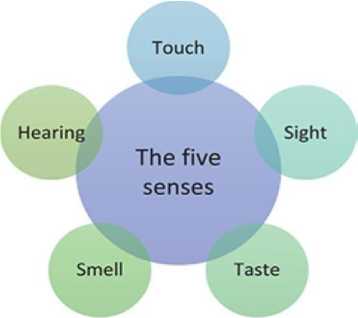
Figure 1. The five human senses Source: Fyall et al., (2019)
Sensory marketing has emerged as a tool to build a positive brand image and customer loyalty and experience as five senses of customer; visual, auditory, olfactory, tactile, and gustative are stimulated (Spies, Hesse, and Loesch, 1997).
This line of thought assumes that stimulating the human senses is crucial to engaging consumers emotionally and intellectually when interacting with products and services (Pine and Gilmore, 1998). Although experiences are individual and internal, comprised of a constant flow of conscious thoughts and feelings (Carlson, 1997), they can be designed (Stamboulis and Skayannis, 2003) and co-created by the visitor and the supplier (Binkhorst and Dekker, 2009), making the experience more valuable to the consumer and, consequently, benefiting the provider and the destination (Scott, Laws and Boksberger, 2009).
The presented theoretical focus of this study is supported by Fyall et al.’s (2019) idea which entails that a successful experience should display at least three of the following key elements: develop an element of surprise/unusual/extraordinary, involve consumers within the consumption process, and develop some of the five senses and create sense. This idea encourages in-depth discussion related to the http://ojs.unud.ac.id/index.php/eot 36
issues studied in this paper in understanding how the experiential marketing concept is involved in the two four-star hotel actors digital marketing and e-commerce channels, in particular, their social media and websites.
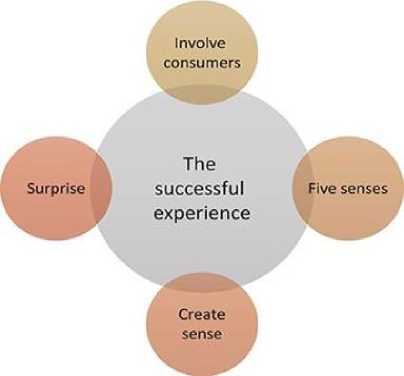
Figure 2. The key experience components Source: Fyall et al, (2019)
METHODS
This is a qualitative study which was conducted through observation and narrative individuals’ experience of the digital and e-commerce channels of the two four-star hotels in Yogyakarta. Content analysis was used to draw conclusions about the data obtained from observation, individuals’ experience, and electronic media of professional publications. Clarifying this, observation was done on Instagram pages and websites of the two four-star hotels in Yogyakarta, Indonesia; Hyatt Regency Yogyakarta and Manohara Hotels which were the main actors of this study, putting focus on the sensory features of experiential marketing in looking how digital marketing and e-commerce enhance hotel experience.
These Four-star hotels have sufficient resources to manage digital technology. Also, they are hotel categories with the highest number of rooms and facilities e-ISSN 2407-392X. p-ISSN 2541-0857
to cater service to the huge population of consumers. Another aspect for using these two actors is that both are four-star hotels but with different operations. One bases its operations internationally and another locally.
RESULTS AND DISCUSSION
As per the analysis of Websites and Instagram pages of Hyatt Regency Yogyakarta and Manohara Hotels, the following was deducted:
Hyatt Regency and Manohara Hotel Websites:
WORlDorHYATI' S 9⅛mτjβn
rf⅜ HYATT ⅛..ιR.9*ney Wataru mmmw
REGENCY’

https://www.hyatt.com/en-US/hotel/indo-nesia/hyatt- regencyyogya-karta/yogya?src=corp_lclb_gmb_seo_yog ya
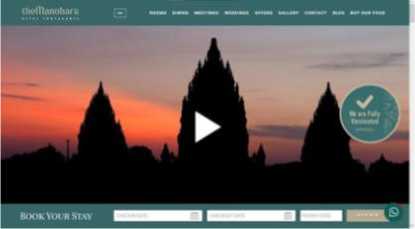
https://themanoharahotelyogyakarta.com/
First, the Hotels’ websites display the names and logos of the hotels, promo videos of the hotels, contact information, rate of the hotels, location of the hotels and shows the direction with the google map of which the map shows directions and uses real-time traffic information to find the best route to the hotels. The directions are
accompanied with voice navigation, which enable to hear traffic alerts, where to turn, which lane to use, and if there are better routes.
Then the websites display various options of which a guest can choose what information he or she demands. The general information options of the hotels from the location, amenities, facilities, services offered and booking options. To a more specific way, there is Rooms option which displays the type of rooms the hotels have, the availability of the rooms accompanied with beautiful pictures of each room cate-
gories.
Another option is Area of Attraction option which shows other services offered near the hotels and other attractions near the hotels. This option helps guests who may want to sleep at the hotel but want to shop at the nearest market or do some day tours and even eat elsewhere. Another option is the Dining. This option shows the food plan catered accompanied with attracting content words and pictures such as “Hyatt regency caters to the taste for the most discerning traveler. Longing for comfort food with friendly atmosphere, Kemangi Bistro features an open show kitchen with a wood-burning pizza oven serving Asian and Western favorites in a casual atmosphere” and “Expert culinary craftsmanship combined with fresh and wholesome ingredients for a dining experience that is guaranteed to be a pleasure to enjoy in our hotel. Our menus featured a wide range of delectable food and beverage designed to always give everyone something to enjoy, all for a dining experience that no one will soon forget.”
More to that, there is Special Events option which shows events venues available for meetings, conferences, weddings or corporate events and other functions. This option shows the number of event venues available both indoor and outdoor with different names accompanied by pictures of the rooms with facilities in it. Convincing e-ISSN 2407-392X. p-ISSN 2541-0857
words are used such as, “Be it meetings at The Residence, conferences at Ballroom, weddings at Merapi Garden, or birthdays at Kemangi Poolside. Our plenty of venue choices, indoor and outdoor, are customizable to your personal themes and needs.” To a more attention capturing way, there is a Photos and Reviews option. This is an option of the photo gallery of all the services offered at the hotels. The options present a photo dump of the hotel’s rooms, dining, restaurants, golf course, meetings, weddings, and people engaging in various activities at the hotel facility. On a more concerning way, the review options show various reviews from customers who once were served by the hotels and frequently asked questions. Reviews are the first thing someone sees when they search the hotel names.
Researchers’ perspective, reviews and frequently asked questions are important options on the websites. They help increase traffic and bookings, as well as make guests feel more confident about their decision to buy service at the hotels. Reviews help bookers to confirm (or disprove) that credibility, so that they can make a well-considered decision whether to book a room or service. Reviews speaks louder of any hotel.
And lastly, is the Offer options. These options show various offers the hotels are giving with very pulling words that create imagery of the offer to individual guests such as: “Take a luxurious break at Hyatt hotels and resorts across Indonesia and get a very special deal; up to 20% off plus free breakfast with a qualifying stay when booking between Dec.15, 2022 and Jan.31, 2023, and staying between Dec.16, 2022 to Sept.30, 2023.”
Researchers’ deducted experience 1:
According to the analysis of the two hotels’ websites, the websites both adopt experiential marketing involving visual,
auditory, olfactive, tactile, and gustative elements although the most visible and powerful elements are visual and auditory. The other three elements are influenced by imagery which a person can obtain by looking at the pictures (aesthetic of the hotel premises) and videos, reading the visual language (contents) and hearing music and sounds. Furthermore, both the websites display at least three of the following experiential elements: an element of sur-prise/unusual/extraordinary; involve consumers within the consumption process, develop some of the five senses and create sense which in general all this entails a successful experience.
However, the level of which the sensory-experiential elements are used in the two websites differ in terms of creativity in expressing the content in such a way that the language and pictures, colors, animations can speak out the most to arose imagery hence enhance experience. In other words, the adoption of the sensory features from the websites, differs in terms of how the elements trigger persuasion, communication (delivering the intended message) and finally causing impact to the customers thus, the urge of purchasing the hotel’s services.
Hyatt Regency Hotel and Manohara Hotel Instagram Pages:
The Instagram pages of the two hotels have at most the same features. They both display the official names of the hotels, location, and contact information. The pages show pictures and video contents (famously known as “Reels”) accompanied with music, colors and visualized words (famously known as captions) of the hotels properties, events held at the hotels like conferences, weddings and birthdays, the rooms, the events venues, amenity tours, room tours, the food catered, people engaging in various activities at the hotels such as swimming, golfing and dining, staff highlights in their uniforms, nearby e-ISSN 2407-392X. p-ISSN 2541-0857
attractions, nearby dining, nearby events, give away (this is an approach of offering free gifts to customers who meet certain criteria in a competition), guest interviews, special offers, surveys and polls on Instagram stories, and guests’ feedback on the comment section.
Researchers’ deducted experience 2:
Just like the websites, the auditory and visual sensory elements of experiential marketing are the most pragmatic of the senses in the Instagram pages of the two hotels. However, the level of creativity in expressing the elements varies between the hotels Instagram pages from the choice of music, colors, visual language and even the engagement of people in activities. A picture or video of people engaging in activity, perhaps swimming, eating at the restaurant, golfing etc., speaks louder than pictures taken of only the swimming pool, golf course or a restaurant.
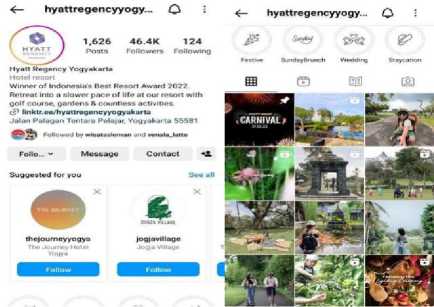

https://instagram.com/hyattregen-cyyogya?igshid=YmMyMTA2M2Y.
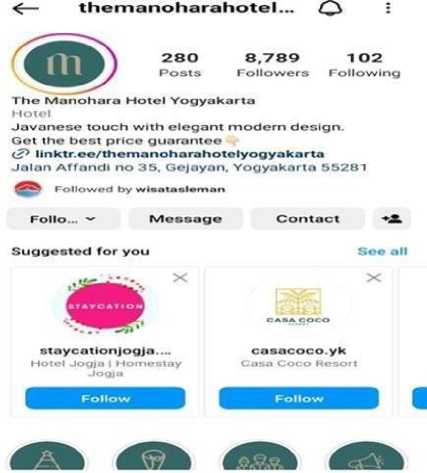
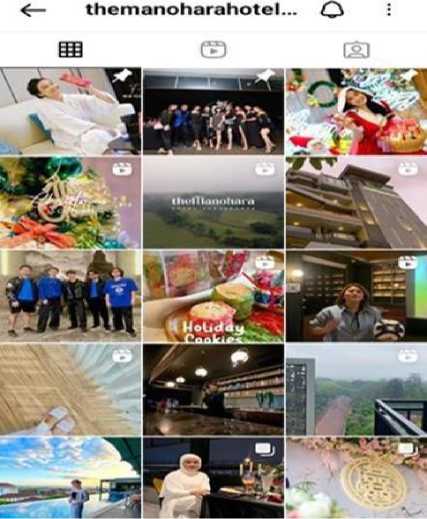
https://instagram.com/themano-harahotelyogya-karta?igshid=YmMyMTA2M2Y
In a more comparative way, previous researchers explain that, when we think about digital marketing and e-com-merce, the marketing approach should not ignore a massive part of human psychology and behavior. Impressions of sound (auditory) have been analyzed empirically by Garlin and Owen (2006) as well as Sweeney and Wyber (2002). The sense of
sound is linked to emotions and feelings and the sense impacts brand experiences and interpretations. Impressions of smell (olfactive) have been discussed by Goldkuhl and Styfve´n (2007) and Fiore et al. (2000). The sense of smell is related to pleasure and well-being and is closely connected to emotions and memories. Taste (gustative) impressions have been analyzed empirically by Biedekarken and Henneberg (2006) and Klosse et al. (2004). The sense of taste is the most distinct emotional sense and often interacts with other senses. The touch (tactile) impressions have been discussed by Peck and Wiggins (2006) and Citrin et al. (2003), among others. The sense of touch is the tactile one, related to information and feelings about a product through physical and psychological interactions. Finally, Krishna and Sokolova (2016) discussed sight which evokes an automatic imagery in consumer’s mind.
Compared to the previous research, this study’s findings of the two hotels websites and Instagram pages show that these hotels’ digital channels do not ignore a massive part of human psychology and behavior. The two four-star hotel actors of this study adopt experiential marketing involving visual, auditory, olfactive, tactile, and gustative elements in their digital marketing and e-commerce hence create excitement and eagerness to consume the hotels’ products. The contents, pictures and videos with musical backgrounds posted on the two hotels’ websites and Instagram pages, taps emotions when navigating through the websites and Instagram pages. Moreover, just like the previous research, this study also finds out that the visual and auditory elements of the experiential marketing are the most pragmatic elements appearing in the websites and Instagram pages of the websites. The other three elements are deducted from looking at the pictures, videos, and visual language. The touch element on the appearance of the silk http://ojs.unud.ac.id/index.php/eot 40
sheets, gustative on the appearance of food and drinks and olfactive from appearance of pictures that suggests smell such as flowers and décor and bed sheets accompanied with background music.
However, this study’s findings differ from the findings of the previous research in a way that it found out it was not only about the experiential marketing elements appearing in the digital marketing and ecommerce channels of the hotels, but the creativity and uniqueness of presenting these elements matters for the effectiveness of the sensory elements communicate, persuade, and impacts the websites and Instagram pages users. The digital channels might involve experiential marketing elements but if it is not presented creatively enough, the target of enhancing hotel experience might not be accomplished to the desired extent. Creativity in colors, animations, choice of words in the contents which gives a more visualized language, arrangement of pictures and realistic/en-gagement of the contents matters. For example, nowadays people are driven by pictures of other people posing in front of beautiful hotel facilities, people eating good food at the hotel, people swimming and people engaging in other activities at the hotels. People love to picture or imagine themselves at the hotels engaging in various activities after seeing others do so. Moreover, the study finds that, the sensory-experiential marketing elements are used by the hotels in digital marketing to stand out in a crowded marketplace.
CONCLUSION AND SUGGESTION
Nowadays in the hotel sector, no matter the type of hotel operations (either domestic or international), building a strong hotel experience in this digital era is not at all easy. One of the most effective ways is to market and sale by utilizing technology and create a memorable
experience. Nonetheless, stimulating and enhancing hotel experience with digital marketing and e-commerce is inseparable with involving the sensory elements of experiential marketing in our approaches. Using sensory elements in digital channels ensures better connectivity and experience to the customers. It means the sensory features should be felt. To improve the quality of hotel service experience in this digital era, it is necessary to invest in experiential marketing which optimizes the sensory elements technique that involves subconscious influence on the senses of customers. This marketing technique affects customers’ judgement, perception, and decision of the hotel’s product.
To the final point, it is not possible to directly use scent, taste and touch sensory features in digital marketing and ecommerce channels such as hotel website, social media or email, but a customer can deduct the smell, touch and scent of hotel based on the appearance of food, rooms, facilities, and décor, ambiance of the hotel. To this point, the visual and hearing features are the most pragmatic experiential marketing elements in digital marketing and e-commerce. Pictures with vivid colors and high resolution as well as high quality sounds are widely integrated into today’s hotels’ Websites, Social Medias, and Contents. They say a picture is worth a thousand words.
Moreover, it is not only about the appearing of the five senses and experiential elements in the digital marketing and ecommerce channels but also how these elements are interestingly, creatively, uniquely, and thoughtful presented matters too in enhancing hotel experience, meaning the extent how the sensory-experiential elements are designed to communicate, persuade and impact users of the hotels’ digital marketing and ecommerce channels.
Limitations/Implications
One among the limitations of this study is that it focuses exclusively on four-star hotels in Yogyakarta Region in Indonesia. Although this category has the highest number of rooms, sufficient resources to manage digital technology and also being the hotel category that caters service to the huge population of consumers, the use of digital technology and e-commerce in enhancing hotel experience can change depending on hotel type/category and even geography. Also, the small sample size may affect the accuracy of the findings. Future studies should thus broaden the sample and expand into more geographic contexts and hotel categories. Finally, the assessing of how digital marketing and e-commerce enhance hotels experience should be broaden rather than only taking sensory elements as the focus.
However, this research study is of particular utility for the hotel industry, although the hotel sector for several years has integrated technology in its service provision, there is few research analyzing how digital technology in particular digital marketing and e-commerce enhances hotel experience. Henceforth, this study is a good addition to the hotel sector digital technology and experiential marketing literature. This paper also relieves hotel managers for more added values especially in marketing plans to create a delighting experience.
Acknowledgement
The previous draft of this paper was presented in International Conference on Intercultural Humanity 2023 organized by Sanata Dharma University and Sogang University, 2nd February 2023, in Yogyakarta. Our gratitude is extended to reviewers and participants of the conference for their constructive feedback.
REFERENCES
Agostini, L. and Nosella, A. (2020) ‘The adoption of Industry 4.0 technologies SMEs: results of an international study’, Management Decision, 58 (4), pp. 625-643.
Alsharayri, M. A. (2011) ‘The ECommerce impact on improving accounting information system in Jordanian Hotels’, International Research Journal of Finance and Economics, 75, pp. 14-23.
Bala, M. and Verma, D. (2018) ‘A critical review of digital marketing’, International Journal of
Management, IT and Engineering, 8 (10), pp. 321-339.
Bang, A. and Roos, C. (2014) ‘Digital marketing strategy within
manufacturing industry–a qualitative case study’, Digitala Vetenskapliga Arkivet, pp. 193.
Bhaleker, P., Ingle, S., and Pathak, k. (2014) ‘The study of E-commerce’, Asia Journal of Computer Science and Information Technology, 4 (3), pp. 25-27.
Biedekarken, O. and Henneberg, S. (2006) ‘Influence of brands on taste acceptance: ice cream brand versus discount brand; brand recognition influences sensory acceptance positively or negatively, an effect that can sometimes be quite dramatic’, Food Engineering and Ingredients, 9 ( 1) , pp. 24-26.
Binkhorst, E., and Dekker, T. (2009) ‘Agenda for Co-Creation Tourism Experience’, Journal of Hospitality Marketing & Management, 18 (2), pp. 311-327.
Bitner, M. J. (1992) ‘Services capes: The impact of physical surroundings on customers and employees’, Journal of Marketing, 56 (2), pp. 57–71.
Carlson, R. (1997) Experienced cognition. New York: Lawrence Erlbaum
Associations.
Carvalho, S. and Carvalho, J.V. (2020) ‘The implications of digital marketing and e-commerce in the tourism sector growth. In Advances in Tourism, Technology and Smart Systems’, Proceedings of ICOTTS 2019, pp. 161-170, Springer Singapore.
Chang, S.E., Shen, W.-C. and Liu, A.Y.
(2016) ‘Why mobile users trust smartphone social networking services? A PLS-SEM approach’, Journal of Business Research, 69
(11), pp. 4890-4895.
Chen, S. and Lin, C. (2019) ‘Understanding the effect of social media marketing activities: the
mediation of social identification, perceived valve, and Satisfaction’, Technology forecasting and social change, 140, pp. 22-32.
Citrin, A.V., Stern, D.E., Spangenberg, E.R. and Clark, M.J. (2003) ‘Consumer need for tactile input: an internet retailing challenge’, Journal of Business Research, 56 (11), pp. 915-22.
Cunha, M.N. (2019) ‘The tourism journey, from inspiration to post-travel phase, and the mobile technologies’ African Journal of Hospitality, Tourism and Leisure, 8 (5), pp.117.
Eze, S.C., S.C. et al., (2020) ‘Critical factors influencing the adoption of digital marketing devices by service-oriented micro businesses in Nigeria: a thematic analysis approach’ Humanities and Social Sciences Communications, 7 (1), pp. 1-14.
Fiore, A.M., Yah, X. and Yoh, E. (2000) Effects of a product display and environmental fragrancing on approach responses and pleasurable experiences’, Psychology Marketing,
17, pp. 27-54.
Fong, L.H.N., Lam, L.W. and Law, R. (2017) ‘How locus of control shapes intention to reuse mobile apps for making hotel reservations: evidence from Chinese consumers’, Tourism Management, 61, pp. 331-342.
García, J. A. C., Galindo, A. D. V., and Suárez, R. M. (2018) ‘The effect of online and offline experiential marketing on brand equity in the hotel sector’, Spanish journal of marketing-ESIC.
Garlin, F.V. and Owen, K. (2006) ‘Setting the tone with a tune: a meta-analytic review of the effects of background music in retail settings’, Journal of Business Research, 59, pp. 755-64.
Goldkuhl, L. and Styfve´n, M. (2007) ‘Scenting the scent of service success’, European Journal of Marketing, 41 (11/12), pp. 1297-305.
Gong, W. (2009) ‘National culture and global diffusion of business‐to‐ consumer e commerce’, Cross cultural management: an
international journal, 16 (1), pp. 83101
Hirschman, E., and Holbrook, M. (1982) ‘Hedonic Consumption: Emerging Concepts, Methods and Propositions’, Journal of Marketing, 46 (3), 92-101.
Hua, N., Hight, S., Wei, W., Ozturk, A. B., Zhao, X. R., Nusair, K., and DeFranco, A. (2019) ‘The power of ecommerce: Does e-commerce
enhance the impact of loyalty programs on hotel operating performance?’, International Journal of Contemporary Hospitality Management, 33 (10), pp. 3514-3534.
Hultén, B. (2011) ‘Sensory marketing: the multi‐sensory brand‐experience
concept’, European business review, 23(3), pp. 256-273.
J. Crolts et al. (2008) ‘A Survey method for identifying key drivers of guest delight’, International Journal of contemporary Hospitality
management, 53 (2), pp. 492-506.
Kannan, P.K. and Li, H. (2017) ‘Digital marketing: a framework, review and research agenda’, International Journal of Research in Marketing, 34 (1), pp. 22-45.
Klosse, P.R., Riga, J., Cramwinckel, A.B. and Saris, W.H.M. (2004) ‘The formulation and evaluation of culinary success factors that determine the palatability of food’, Food Service Technology, 4 (3), pp. 107-155.
Krishna, A., Cian, L., and Sokolova, T. (2016) ‘The power of sensory marketing in advertising’, Current Opinion in Psychology, 10, 142-147.
Leonard, L.N.K. (2011) ‘Attitude influences in C2C e-commerce: buying and selling’, Journal of Computer Information Systems, 52 (3), pp. 11-17.
Li, y. (2000) ‘Geographical consciousness and tourism experience’, Ann. Tourism Res., 27 (4), pp. 863 883.
Lucking-Reiley, D., and Spulber, D. F. (2001) ‘Business-to-business
electronic commerce’, Journal of Economic Perspectives, 15(1), pp. 5568.
Magano, J. and Cuncha, M.N. (2020) ‘Digital marketing impact on tourism in Portugal; a quantitative study’, African Journal of Hospitality, Tourism & Leisure, 9 (11), pp. 1-19.
Mariani, M.M., Di Felice, M. and Mora, M. (2016) ‘Facebook as a destination marketing tool: evidence from Italian regional destination management organizations’, Tourism management, 54, pp. 321-343.
Mcintosh, A.J. and Siggs, A. (2005) ‘An exploration of the experiential nature of boutique accommodation’, Journal of Travel Research, 44 (1), pp. 74-81.
Mkwizu, K.H. (2020) ‘Digital marketing & tourism: opportunities for Africa’, International Hospitality Review, (1), pp. 5-12.
Neutrofer, B., Buhalis, D., and Ladkin, A. (2015) ‘Smart technologies for personalized experiences: a case study in the hospitality domain’, Electronic Markets, 25(3), pp. 243-254.
No, E. and Kim, J.K. (2014) ‘Determinants of the adoption of travel information on smartphone’, International Journal of Tourism Research, 16 ( 6), pp. 534-545.
Parvez, S. J., Moyeenudin, H. M., Arun, S., Anandan, R., and Janahan, S. K. (2018) ‘Digital marketing in hotel industry’, International Journal of Engineering & Technology, 7(2.21), pp. 288-290.
Peck, J. and Wiggins, J. (2006) ‘It just feels good: customers’ affective response to touch and its influence on persuasion’ Journal of Marketing, 70, pp. 56-69.
Pine, B.J. and Gilmore, J.H. (2011). The experience economy. Harvard Business Review Press, Boston.
Pine, J., and Gilmore, J.H. (1998).
Welcome to the experience economy. Harvard Business Review, 76 (4), pp. 97-105.
Quinlan-Cutler, S., and Carmichael, B. (2010) ‘The dimensions of customer experience. In: M. morgan, P, lugos, Ritchie (org) (Eds.). The tourism in leisure experience: consumer & managerial perspectives’, Aspects of tourism, pp. 3-26, Bristol.
Reid, Robert D. and Bojani, David C. (2018). Hospitality Marketing Management, 4th Edition. New York: John Wiley & Sons Inc.
Schmitt, B.H. (2000). Experiential Marketing. Deusto, Barcelona.
Scott, N., Laws, E., and Boksberger, P. (2009) ‘The Marketing of Hospitality and Leisure Experiences’, Journal of Hospitality Marketing &
Management, 18 (2-3), pp. 99-110.
Segittur (2014). Impacto de la innovacio’n y las nuevas technologies en los ha’bitos del Nuevo turista en Espania. Retrieved from:
www.segittures/opencms/export/sites /segiturl.content/galerias/descargas/d ocumentos/Ipacto-de-la-Imovacin-y-las-nuevas-tecnologas-en-los-hbitosdel-to-pdf.
Spies, K., Hesse, F., and Loesch, K. (1997) ‘Store atmosphere, mood and purchasing behavior’, International Journal of Research in Marketing, 14(1), pp. 1–17.
Stamboulis, Y., and Skayannis, P. (2003) ‘Innovation strategies and technology for experience based tourism’, Tourism Management, 24 (1), pp. 3543.
Sweeney, C.J. and Wyber, F. (2002), ‘The role of cognitions and emotions in the music approach-avoidance behaviour relationship’, Journal of Services Marketing, 16 (1) pp. 51-70.
Werthner, H., and Ricci, F. (2004). Ecommerce and tourism.
Communications of the ACM, 47(12), pp. 101-105.
Xu, S., Kim, H.J., Liang, M. and Ryu, K. (2018) ‘Interrelationships between tourist involvement, tourist
experience, and environmentally responsible behavior: a case study of Nansha Wetland Park’, Journal of Travel and Tourism Marketing, 35
(7), pp. 856-868.
Yasmin, A., Tasneem, S. and Fatem, K. (2015) ‘Effectiveness of digital marketing in the challenging age: an empirical study’ International Journal of Management Science and Business Administration, 1 (5), pp. 69-80.
http://ojs.unud.ac.id/index.php/eot
45
e-ISSN 2407-392X. p-ISSN 2541-0857
Discussion and feedback